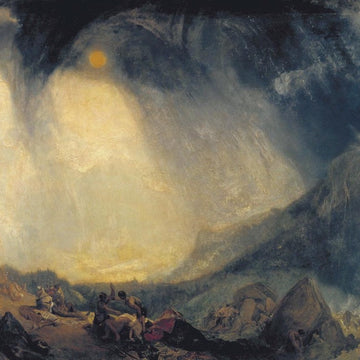Art history is often reduced to a footnote in school, but it should be given a more prominent place because the history of art is the history of human thought around the world. When we study the artists of the past, we gain insight into society and into practical art techniques that will help us in our practice!
Today, let’s go over some fun facts from art history and start thinking about where we came from. These facts come from a wonderful textbook by Marilyn Stokstad and Michael W. Cothren, called Art History.
1. Today’s Art Styles are Influenced by Romanticism

Romanticism was a 19th-century movement in visual art, poetry, and literature that centred around personal experience. Instead of adhering strictly to tradition, artists experimented and paid attention to their ideas and feelings, often intending to draw nearer to feelings of insight and transcendence.
Artists today who are “searching for their art style” are following Romanticist ideas, because in the past, the painting was taught according to one academic ideal, and each artist’s unique style was something that happened coincidentally.
Our featured painting here is Snowstorm: Hannibal and His Army Crossing the Alps, by Joseph Mallord William Turner.
Turner’s goal as a Romantic-era painting was to capture sublime moments - moments where the vastness and majesty of the scene made the viewer feel their small place in the world. Notice how the shapes in the background are loose and vague since the focus is on the power of the snowstorm rather than on minute realistic details.
2. Modern Urban Sketching Comes From Impressionism

After Romanticism came Impressionism and most Plein air watercolourists today are Impressionists to some degree or another whether they know it or not. After the invention of the paint tube, artists could travel with paint more easily, and paint what they saw wherever they went.
This painting, Impression: Sunrise by Claude Monet, is one of the earliest examples of the Impressionist style. Monet himself sums it up best:
“When you go out to paint, try to forget what objects you have before you—a tree, a house, a field, or whatever. Merely think, here is a little square of blue, here an oblong of pink, here a streak of yellow, and paint it just as it looks to you the exact colour and shapes until it gives your naive impression of the scene before you.”
This way of thinking is how watercolourists today interpret their subjects, especially while painting outside! Impressionism was all about painting a scene quickly to capture that exact moment’s light, and that’s exactly how urban sketching works today. Plein air painting works the best with a limited colour palette, and you can see that Monet used mainly two colours in his sunrise painting.
3. Masters Studied One Another’s Work

While learning art, we’re often encouraged to study the paintings of old masters. Most of the time, it’s encouraged for students to copy the master’s painting exactly, while other times it is fun to reinterpret the old work in your style. This practice goes way back in time, and even the most studied masters of today studied previous masters!
Here you can see Van Gogh’s reinterpretation of a piece by Hiroshige called Plum Orchard, Kameido. When Van Gogh discovered art from Japan, he was enthralled because nobody he knew in Europe painted in that unique style.
He made a painting called Japonaiserie: Flowering Plum Tree to study the unique lines and composition of Hiroshige’s painting while using his painting style to see how it would look.
4. Sketchbooks have Existed for Centuries

Since you don’t see many sketchbooks in museums, it might not occur to you that the practice of sketching has been around for a long time! Most sketchbooks don’t last over time because they aren’t cared for like finished paintings.
This sketchbook page from Villard de Honnecourt in about 1230 is especially fun to look at because you can see him practising geometric forms. Medieval art was not well-proportioned or anatomically accurate compared to nowadays, but artists still used circles, triangles, and other shapes to make sure they were drawing lines in the right places.
It’s extra fascinating to see the star shape being used because current artists don’t use that one so much.
5. Cartoon Animals Have Been Popular for a Thousand Years

Comics and picture books are seen as mostly 20th-century products, but here is a comic-like work of art from 12th-century Japan! The artist and Buddhist abbot Toba Sojo created this playful set of scrolls called Choju Giga, translated to Frolicking Animals.
This scene here is a parody of Buddhist life, where a frog is sitting on a lotus leaf posed as Buddha, and other animals worship him. The exact nature of the story is lost in time since there is no text to accompany the images, but the lively drawings and expressive characters have timeless appeal.
After learning these art history facts, I hope you are inspired to dig deeper into the history of different cultures around the world and collect ideas from the masters in the past! You will be surprised how much of today’s art is directly influenced by older movements.
For more articles like this one, be sure to subscribe to our email newsletter!



3 comments
So cool!
———
Etchr Lab replied:
So glad you found this useful! :) Thanks for reading!
- Ânia
wow so amazing
Very interesting and informative, thank you!